UNIVERSITY OF CENTRAL PUNJAB
|
PEACHTREE ACCOUNTING
|
| SUMITTED TO : SIR BILAL SARWER |
| SUBMITTED BY : BAKHTIAR MEHMOOD MALIK |
| L1F10BCOM0048 |
Contents
Setup of a company
CHARTS OF ACCOUNTS
Entering Beginning Balances for Accounts
Maintaining the Customer List
Maintaining Customer Defaults Info.
Maintain Vendors
Vendors Default Info.
Maintain Inventory
Enter the beginning balances of inventory items
After adding the inventory item into Peachtree you will also need to enter the beginning balance of each item of inventory. You can either enter the beginning balance of each item as you create the item using the Maintain Inventory Items window. However, if you are creating several items of inventory at once, you can enter the beginning balances of these items altogether at the same time.
To enter the beginning balance of each inventory item, click the Beginning Balances arrow down the bottom right hand corner of the Maintain Inventory Items window.
Setting Up an Assembly Item Purchase Order:
Recording Purchase Order:
Purchases/Receive Inventory
Payments Quotes/Sales Order
Conversion of Quotes to Sales Order
Sales Order Sale Invoice
Receipts
Maintain Global Options
Accounting:
General:
Peachtree Partners:
Setup of a company
To setup a new company in peach tree click the icon of peach tree and the following screen would appearFrom this screen click on setup a new company. A wizard will start on the introductory window.
Then click next to start and a company profile window will appear .
Then fill the required fields in the company information and click the next button. Then the chart of accounts window will appear
There are 5 options given in this charts accounts section
- By selecting the first option we can get the chart of accounts for the retail, service, Manufacturing or distribution company which has been produced by the software itself and they can be modified according to the user. If your click this option and click next we will seethe following window.
Now by clicking on the button View charts of accounts. Following chart of accounts would appear.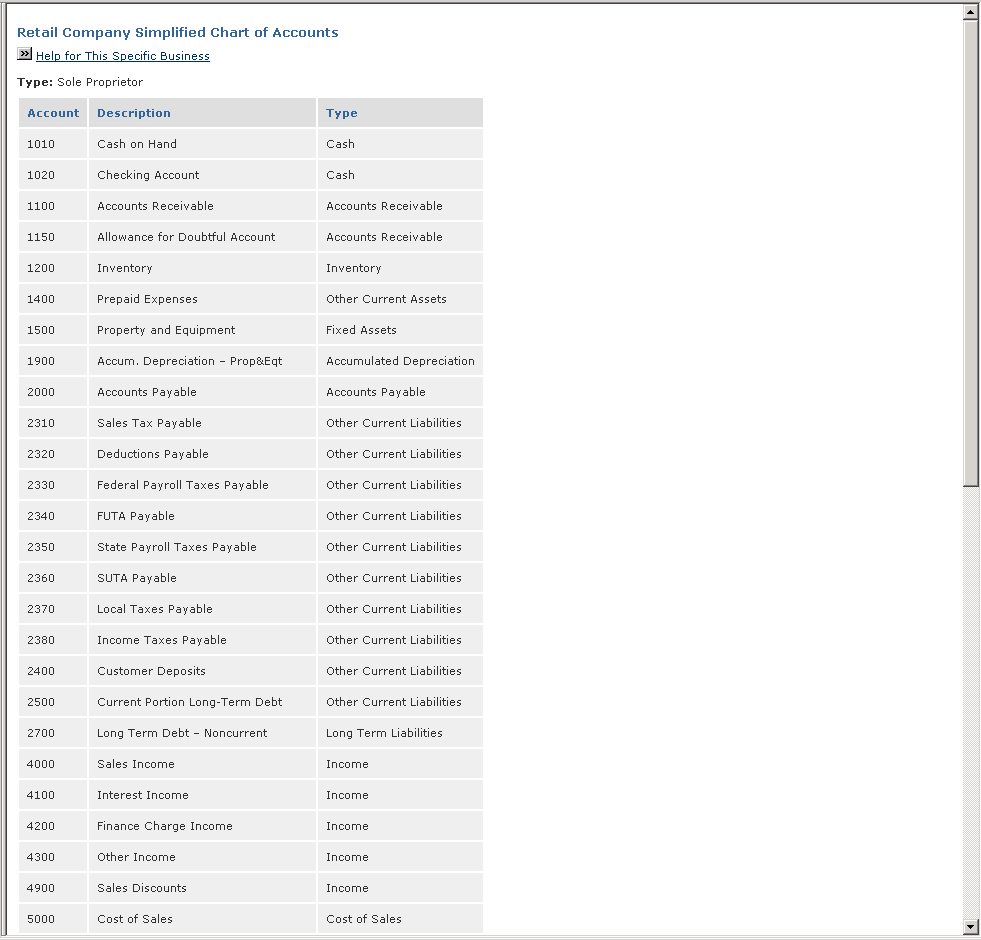
- To get the chart of accounts of any sample company which have been produced by the software itself. By selecting this option and then clicking next we would see the following option.
- Third one allows you to get the charts of accounts from any previously existing company in the software .
- To change the accounting program. The software would ask you that which accounting system would you like to choose for your accounting program accrual or cash basis.
Then the software would require that how do you want to process your transaction real time or batch. Real time means the transactions are processed by the software as they r processed and saved. Most of the companies use this system for their transactions. Batch means that the transactions are posted and then processed in a group. This option allows printing the registers and analyzing group of transactions before posting to the journals.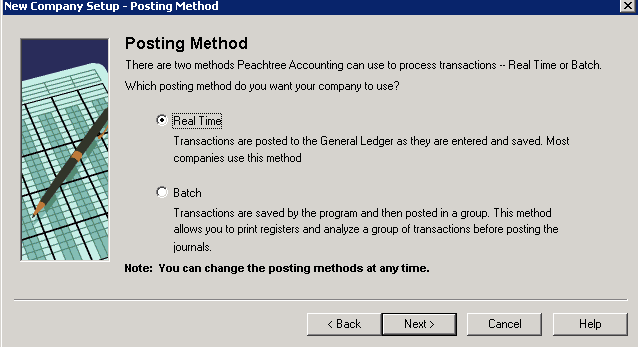
Then by clicking next the software would require the accounting period for your company the accounting period is generally made with the calendar of 12 months but there is an option if you don’t want to go with the calendar months and use an accounting period of less than or more than 12 months.
After you select the accounting period click next and then we would see a window requiring monthly accounting period. This means that from which month of the year the accounting period would start and when are we starting to enter the data or the entries in the software. For example most of the companies use the accounting period starting from 1st July to 30th June. So you just have to select the month when your accounting period is starting.
And then select that when are you starting to enter data or transactions into your software of the company.
Once you are done all of it then you going to get the congratulated by the system. Then click finish to save all the data you have entered of your company and start
- To build your own chart of accounts for your company
In this follow the same procedure as used above for the fourth option
Once you have clicked on the option of finish the software would automatically save the data and make a folder in the program files listed in C drive
To see that click My computer then C drive then click program files there would be a folder of peach tree in that then click that there would be a folder of company click that there would be a folder placed in there with the name of your company.
Now once the company is created we will start making thechart of accounts of the company as we choosed the option of create own company when the software asked about the chart of accounts .After clicking on finsh some screen like this would appear
CHARTS OF ACCOUNTS
Now to add the chart of accounts the click on the maintain menu placed on the top under the title bar of the window
You will get a window some what like this
First there is an option of entering the account id in which we will write the numeric id which has been allotted to the specific account to be entered then press tab and the cursor would move to the description box. Then there is another box for the description in which we would write the account name which has to be entered. Enter the name of the account and press tab key. The cursor would then automatically move to the account type option. There you need to select the account type from the list given. To find the account type quick we can press the key of the starting letter e.g if you need to give the account type as cash you can click on the “C” button on your key board till the time cash appears. Set the account type and press the save button on the top of the widow to save or press the keys “Alt” plus “S”. The accounts would get saved in the chart of accounts. Then the same way enter all chart of accounts.
To check back the charts of accounts or to access them and retrieve them click the magnifier button on the right side if the account id box a drop down menu would appear like below.
There you can see the record of all the chart of accounts you have entered along with the account id account description and the account type. By double clicking any account you need you can access that account.
Then on another right side if the magnifier button there are two buttons consisting opposite pointing arrows they are the next and backward button to work on the next account to which is opened click the next button i.e. the extreme right button in which the arrow is pointing to the right side. And to revert back to the immediate back account click the button in which the arrow is facing to the left side.
Now to check the full list of the the accounts that you have entered click “Reports” button on the top in the menu bar this would open a drop down menu. Click the general ledger option from that menup
By clicking on the general ledger option a dialogue box will open some what like the following
From this table click on to the chart of accounts option to see all the charts of accounts to see the list of all the chart of accounts created by you. We can check the function of that option on the report description
The above table shows all the chart of accounts that has been created
Entering Beginning Balances for Accounts
In this topic you will learn how to enter the beginning balances of the accounts and for this you have to follow the following steps:
Step 1: Go to the menu bar and select the maintain tab and click on the chart of accounts, you will find the following window. 
Select the Beginning Balances button on the General tab of the Maintain Chart of Accounts window to enter beginning balances for general ledger accounts. You use this to enter the beginning balance for the account or to adjust the balance for an account in a previous period.
Step 2: once you click on the beginning balance button, you will get a small window to select the period for which you are going to enter the balances.
Step 3: After selecting the period, you will find the following where you have to enter the balances for the accounts you have created before.
The columns where you enter amounts for accounts on these two windows are set up to give you a better feel for how the different accounts in your chart of accounts affect the balance of your finances. When you finish entering balances for all of your accounts, the total of the amounts in the Assets, Expenses column must equal the total of the amounts in the Liabilities, Equity, and Income column. If not then Peachtree will automatically adjust your trial balance by creating an account that is beginning balance equity account.
Note: If you have not created the Retained Earning account, your balances will not be saved, however you can make the account on the same window by clicking on the tab NEW but the effect of the account will be after you re-open the same window.
Maintaining the Customer List
In this topic we are going to discuss how to make your customers list.
Step 1: In the menu bar, go to the maintain bar and click on the Customers/Prospects.
Step 2: after clicking the Customers/Prospects in maintain bar you will get the window like following: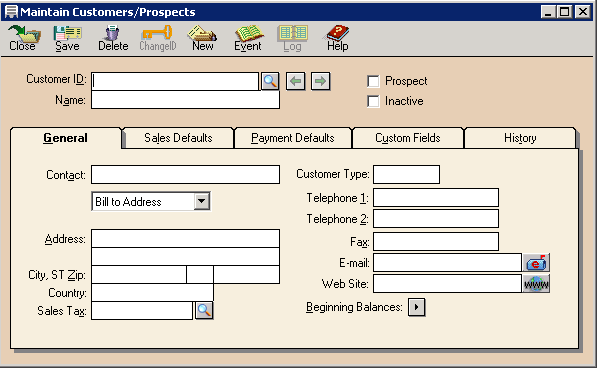
Use the Maintain Customers/Prospects window to enter, change, and store information about companies and people to whom you sell goods and services. You can also enter information about companies and people with whom you would like to do business (prospects).
General Tab:
In this tab, we basically enter the information about the customer such as Name, Address, Country, type of Customer, Telephone, Email and Beginning balances etc.
Sales Defaults Tab:
To set up unique sales transaction defaults for each customer record, You can change this information at the transaction level, if necessary.
In Sales Representative field, we can enter the sales representative that has contact with the customer and for this purpose we must have entered in the Maintain Employees/Sales Reps window.In G/L Sales Account, we select the general ledger sales account for the customer and without selecting this will not effect the sales transaction to general sales ledger account which is an income account.
Maintaining Customer Defaults Info.
For the purpose of setting customer defaults information, we have to follow the following steps:Go to the maintain menu and from in select the default info and click on customers, you will get a new window like the below one:
In this picture you can see the 5 tabs, Payment terms, Account Aging, Custom Fields, Finance Charges and Pay Methods.
Payment Terms:
In standard terms, there are five options which includeC.O.D, Prepaid, and Due in number of days, due on day of month, due at end of month: Select one of these to tell you the type of payment your customers make.G/L Link Accounts:
The defaults are used to link sales income and sales discount G/L accounts to most of your customers. You change individual customer setup, if necessary.Account Aging:
To set up how sales invoices are aged and what aging brackets will be used for accounts receivable, select the Account Aging tab in the Customer Defaults window.In this window, there are two options:
- Age Invoices by
- Aging Categories
Age Invoices by:
In this option, there are two methods either to select the invoice date or due date. If you select the invoice date, this will show you how old are the customer invoice and balance. If you select the method Due date, this will shoe you how much overdue is customer invoice.Aging Categories:
In this option, you can make your own criteria to filter the receivables according to the time period criteria you made.Custom Fields:
To set up custom field names for your customer records, select the Custom Fields tab in the Customer Defaults window.Custom fields let you use your imagination. What do I really need to know about my customers? Select the Enabled check box to enter or change the field label. If you decide not to use a field, clear the Enabled check box.
Finance Charges:
In order to apply the finance charges, you have to check the check the box or you can set according to your own choice by applying it on the invoice according to your defined criteria.Pay Methods:
This field header is used to set up payment methods for thecustomers; you can set up to 10 payment methods to facilitate the customer.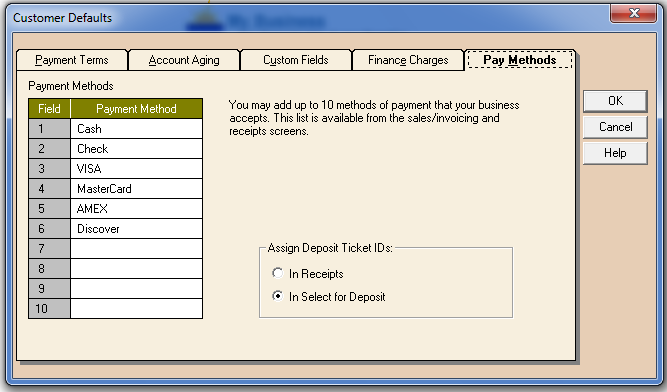
Maintain Vendors
Following are the steps to create a Vendor:- First of all go to the Maintain Menu and select the Vendors, you will get window of Maintain Vendor.
- There are two fields: Header and Tab field.
- In the Header field type the Vendor id and the name of the Vendor.
- In the General tab, enter the general information about the vendor such as contact information, address, telephone and website etc.
- In the Purchase Defaults tab, most important is to select the GL Purchase Acct. to which the purchases will be charged, selection of shipping and delivery method.
- In the Custom Field tab, you can enter the additional information of the vendor.
- In the History tab, you can review the past transactions with the vendor.
Vendors Default Info.
- Go to Maintain Menu and click the Default Information then select Vendors option, you will get following screen to enter the Vendors default information.
- There are four tabs such as Payment terms, Account Aging, Custom Fields and 1099 settings.
- In the payment terms, first you select the standard payment terms and provide the id information for the GL Purchase Acct and Discount GL Acct. in the GL Link Accounts.
- In the Account Aging tab, you can either use invoice date or due date method to age the Account Payables or you can use aging categories to filter the payables by setting your own range.
- In the Custom Fields, you can provide additional information of the vendor.
Maintain Inventory
Before you are able to record transactions relating to inventory, you first need to set up your inventory items in Peachtree. This topic shows you how to add an inventory item into Peachtree, and how to modify or delete an item of inventory should the need arise.
Creating an item inside Peachtree is a very simple process:
Go to Maintain -> Inventory Items. The Maintain Inventory Items window appears.
This displays the Maintain Inventory Items window where you can enter the details of the inventory item into Peachtree. The following screenshot show step-by-step instructions on how to enter an inventory item into the Maintain Inventory Items window in Peachtree.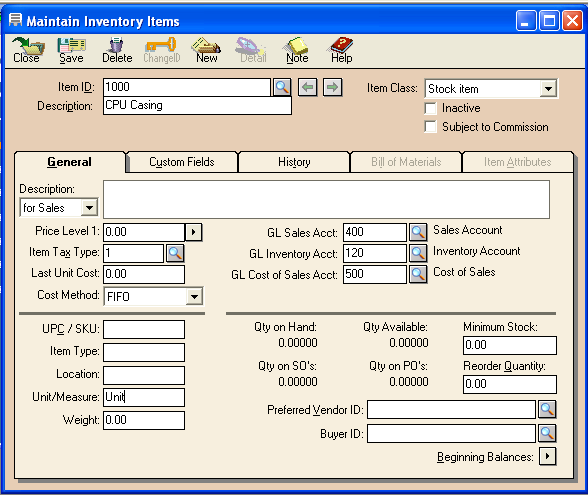
Item ID: Enter a short identification code for the item of inventory.
Description: Enter a short description of the item of inventory.
Item Class:
Select the class of the item from the drop down list provided. For items of inventory to be resold you should select 'Stock item.
General Tab:
Enter the relevant information about that item. Note that for stock items you do not need to enter information into the Last Unit Cost field. Peachtree will automatically update this field when you enter the beginning balances of inventory items into Peachtree. Notice that there are three general ledger account fields on the MAINTAIN INVENTORY ITEMS window: GL SALES ACCT, GL INVENTORY ACCT, and GL COST OF SALES ACCT. For a STOCK ITEM, none of these fields can be left blank.
Other tabs:
Enter the required information in the other tabs. Note that if the Item Class selected is Stock item, you are unable to enter any information into the Bill of Materials tab or the Item Attributes tab. This is because the Bill of Materials tab is used only if the Item Class selected is Assembly, while the Item Attributes tab is only used if the Item Class selected is Master Stock item.
Once you have entered the information in the Maintain Inventory Items window, remember to review your entries and save the item of inventory by clicking the Save icon.
Enter the beginning balances of inventory items
After adding the inventory item into Peachtree you will also need to enter the beginning balance of each item of inventory. You can either enter the beginning balance of each item as you create the item using the Maintain Inventory Items window. However, if you are creating several items of inventory at once, you can enter the beginning balances of these items altogether at the same time.
To enter the beginning balance of each inventory item, click the Beginning Balances arrow down the bottom right hand corner of the Maintain Inventory Items window.
This will open the Inventory Beginning Balances window. The following screenshot and description show step-by-step instructions on how to enter the beginning balance of an inventory item into the Inventory Beginning Balances window in Peachtree.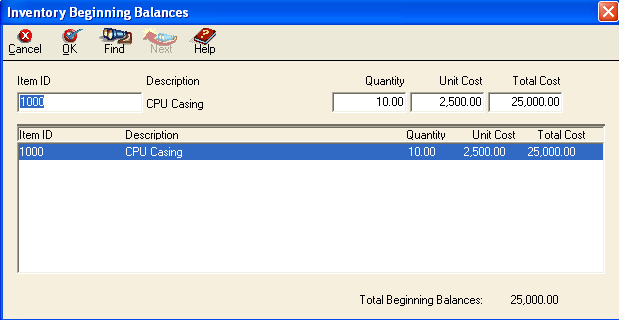
List of Inventory Items: Select the item of inventory from the list by clicking on it.
Item ID and Description: Note that the Item ID and the description of the item selected appear at the top of this screen, Confirm that you have selected the correct item.
Quantity: Enter the number of units of that inventory item on hand in the Quantity field.
Unit Cost: Enter the purchase price (unit cost) of one unit of that item of inventory.
Total Cost: Notice that Peachtree automatically calculates the total cost of that many items of that type of inventory.
Once you have entered the information in the Inventory Beginning Balances window, remember to review your entries and click the OK icon to save the information and update the inventory totals.
Setting Up an Assembly Item
An assembly is made up of other items in your inventory; so when you build an assembly item, you can only build as many as you have components.There are two steps to creating an assembly item:
1) Define the items (components) the assembly contains.
2) Build the assembly. Additionally, you can purchase prebuilt "assemblies."
From the Maintain menu, select Inventory Items. Peachtree displays the Maintain Inventory Items window. Enter the ID of the assembly, and select Assembly as the item class. An ID can be created from the Description you enter.
After you finish filling out the window, select the Bill of Materials tab. Select item IDs for existing stock items or assemblies only, and enter the quantity. Press ENTER. Do this for each item that makes up the assembly. When you're finished entering the assembly item, select the Save button.
When you are finished entering inventory items, select the Close button.
Next step is to enter the beginning of the stock items that make the assembly item. Select the Assembly item on the Maintain Inventory Items window; click the Beginning Balances arrow down the bottom right hand corner of the Maintain Inventory Items window.
In this way the process of making assembly is finished, now you can check it by going Tasks Menu and select the Assemblies.
Once you click on it, a window Build/Inbuilt Assemblies will be open.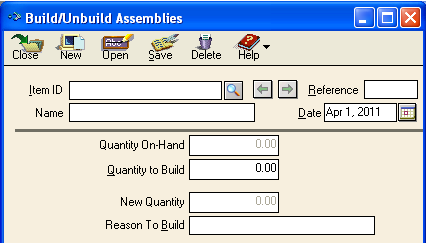
In this window, you have to give Assembly item id and the quantity to build, if you do not have the sufficient stock to build the required assemblies, a warning message will be appear that the assemblies cannot be made due to the insufficient stock.
Purchase Order:
A Purchase order is a written document issued by buyer to seller indicating items, quantities and prices for the products or services the seller will provide to the buyer.Recording Purchase Order:
This topic shows you where and how to record details of a purchase order in Peachtree. To record a purchase order in Peachtree, open the Navigation Aids on the Peachtree today window as shown below: Click on navigation aids and selects the Purchase section and now click on the Purchase order.Another way to open the Purchase order is:
1-Go to the Task Menu
2-Click on the Purchase order, a Purchase order screen will appear.
Purchase Order Window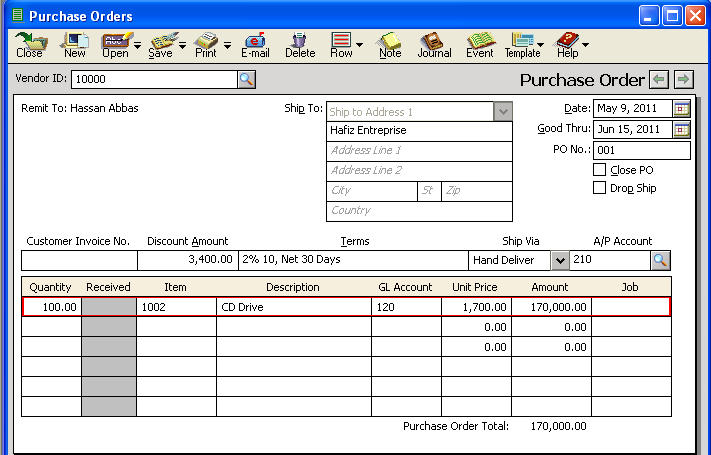
- Select the vendor id, who will supply the goods.
- Once you select the vendor id, “Remit To and Ship To” fields will be completed automatically by the Peachtree.
- Next step is to select the purchase order date.
- As you select the purchase order date, Peachtree automatically estimates the good through date as 30 days however, you can change it.
- It is essential to enter the purchase order number, do not leave it blank.
- Enter the specific quantity required to be ordered.
- Select the item that is required and the description field automatically fills as you select the item. Whereas Peachtree automatically estimates the GL Account, Unit Price and amount with the default information specified when that item was created.
- Once you complete all of the above steps, click the save button to record the purchase order however these entries are not posted to the general ledger until the goods received information is posted.
Purchases/Receive Inventory
Once you have made the purchase order, the next step is to receive the inventory against that purchase order and to record in the Peachtree software.
Following are the steps to record received inventory:
- Choose the task menu and click on Purchases/Receive Inventory.
- Type the vendor id or click on look up button to see list of vendors and select the one, if you had entered a purchase order against him, Peachtree displays the Apply to Purchase order tab. After you select a vendor, Peachtree automatically fills the Remit to and Ship to fields.
- Select the date of receiving inventory.
- Then type the invoice number, which is very important. If you receive inventory without invoice then check the waiting on bill but if you received both inventory and bill leave the box unchecked.
- Now on the apply to purchase order no. tab, click the drop-down list and select the Purchase Order against which you have received the inventory.
- After selecting the Purchase Order, on each line in the received box type the quantity you received. This quantity can be less than, equal to or more than you ordered. If the inventory received is less than you ordered, then the PO remains as open PO. However if you received equal to or more than you ordered then the PO get closed.
- If you select a vendor against which no purchased or is issued, you can enter a purchase without any PO in the Apply to Purchases tab. Sometimes you call your vendor for the item that is not mentioned on PO but on the purchase invoice you can add them here.
- Click the save button to post the transaction.
Payments
- Choose the task menu and click on Payments.
- Select the id or name of the vendor, Peachtree automatically displays the name and address of the vendor.
- When we select the vendor, Peachtree displays a list of purchase invoices that are still to be paid in the Apply to invoices tab.
- If a check is paid for an invoice then type the check no. in the check number field.
- Select the date of payment.
- In the Apply to Invoices tab, you may have more than one outstanding invoice and for the payment you can click the box in the Pay column for the full payment of that invoice; however you can make the partial payment type in the amount in the amount paid column.
- Click the save button to post the transaction.
Quotes/Sales Order
Following are the steps for making quotes to the customer:- Go to the task menu and from Quotes/Sale order sub menu, select the Quotes tab.
- First of all type the customer id in the customer id field for the customer.
- After selecting the customer, bill to field will be filled automatically by the Peachtree software.
- Next step is to enter the address detail for the delivery of goods.
- Now select the date of issuing quotation.
- In the goods through field, select the date till than the quote is valid.
- The most important is to give the quotation number.
- You can enter the customer purchase order number if it is provided, otherwise leave it blank.
- Next step is to choose the shipping method, as far as terms are concerned these will be automatically appears when you select the customer.
- Next step is to enter the quantity required, select the item for which you are quoting the quote and description appears automatically.
- Now enter the unit price of the item, once you enter the price Peachtree calculates amount automatically.
- In the bottom, there are two options such as sales tax and freight charges. You can enter the both.
- Once you have entered the information click the save icon.
Conversion of Quotes to Sales Order
- Go to the task menu and from Quotes/Sale order sub menu, select the Quotes tab.
- Click on the Open button to see a list of created quotes and select the one to be converted.
- Next step is to change the date of quote.
- Now click on the convert button, a dialog box will be open with the three radio button options.
- Select the third radio button and enter the sale order number in the SO # field.
- Click the save button to record the transactions.
- After the conversion, you will not find it in the quote window but from sales order window you can check it.
Sales Order
- Enter the customer id or click the lookup button to see a list of customers.
- Once selected, bill to field will be completed automatically and you can enter the ship to detail.
- Next step is to select the date of making sale order.
- Now click the calendar icon to select the date by which the goods are required to have shipped.
- Next and important step is to enter the sale order number, can also enter the customer purchase order number if known but not compulsory.
- Next step is to enter the quantity required, select the item of the inventory ordered and description appears automatically.
- Now enter the unit price of the item, once you enter the price Peachtree calculates amount automatically.
- In the bottom, there are two options such as sales tax and freight charges. You can enter the both.
- Once you have entered the information click the save icon to record the sales order.
Sale Invoice
- Enter the customer id or click the lookup button to see a list of customers.
- The Bill To and Ship To field will be automatically filled by Peachtree but however you can change it.
- If against the customer selected had already issued a sale order, tab will shift to apply to Sales order. After selecting the sale order, change the date, enter the sale invoice no. and enter the quantity on the each line of shipped column and click on the save button to post the transaction.
- However you can also record direct sale invoice, for this forget about the step no.3 and follow the remaining steps.
- Now select the date of making sale invoice and enter the sale invoice no. in the sale invoice field.
- Enter the number of units of the first inventory item sold.
- Type in the Item ID of the item of inventory sold.
- When you select the item id, Peachtree automatically fills the description field.
- Peachtree automatically calculates the GL Account, Unit Price and Amount column with the default information provided however you can change it according to need.
- You can enter the Sales tax and freight charges, Peachtree automatically populates the total invoice value.
- After making the above adjustments click the save button to post the transaction.
Receipts
- First of all select the customer id and Peachtree will automatically displays the address of the customer.
- Once you selected the customer, Peachtree automatically displays a list of the customer's outstanding invoices.
- Next step is to enter the Reference and Receipt No.
- Now select the date on which you have received the payment.
- Select the method of payment from the drop down list provided and appropriate cash account.
- If the customer has paid the full amount of the invoice, then click the Pay box for that invoice to enter a check mark in that column.
- If the customer only made a partial payment against a particular invoice, type in the amount of that payment in the amount paid column.
- Last step is to click on the save icon to post the transaction.
Maintain Global Options
The Global options set defaults that are in effect for all Peachtree companies. Global options allow the user to specify how Peachtree opens companies and displays data. To open the global option, click the OPTIONS on the menu and select the very first option “GLOBAL”.A new small window will open from which you can set the desired the settings.
There are four tabs of the global options.
Accounting:
In accounting tab, there are different options for the setting. For instance, the user can set up the decimal setting while entering the numerical figures while entering the data. Whether hide the general ledger accounts of the account receivable or account payable. It also includes other options. It is set according to the user desire.
General:
In general tab, there are general options regarding the software. It includes the performance, smart data entry, color scheme, line item entry display.
Peachtree Partners:
In the Peachtree partners tab, the user sets the security level that determines how the applications interface with Peachtree data. There are 3 security level which are offered.
- Low
- Medium
- High
Spelling:
In the spelling tab, user can activate the spell check. By activating the spell check feature it checks the spelling in different areas of the software. With addition, it also check the basic grammatical errors, such as incorrect capitalization that are typed together without a space between them or repeated words.